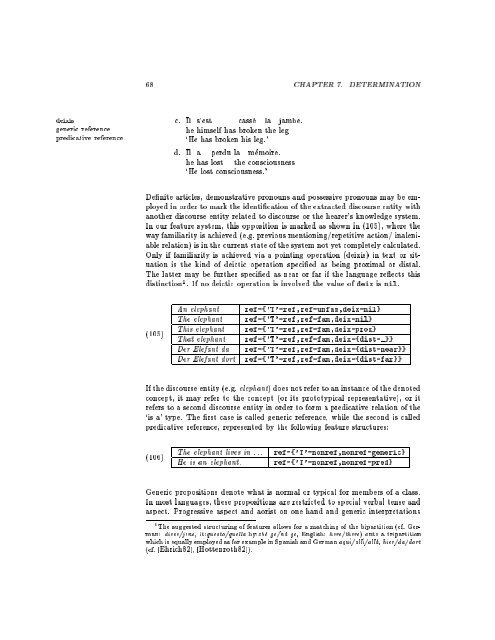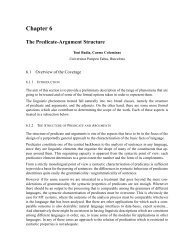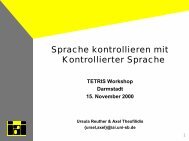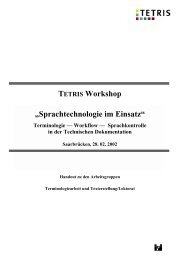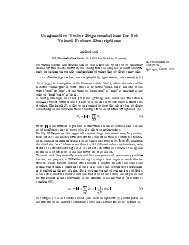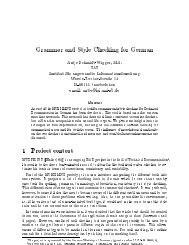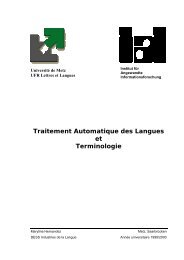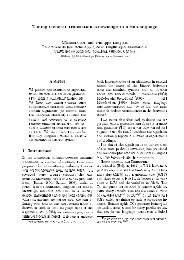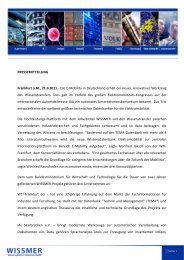Linguistic Modeling for Multilingual Machine Translation
Linguistic Modeling for Multilingual Machine Translation
Linguistic Modeling for Multilingual Machine Translation
You also want an ePaper? Increase the reach of your titles
YUMPU automatically turns print PDFs into web optimized ePapers that Google loves.
68 CHAPTER 7. DETERMINATION<br />
deixis<br />
generic reference<br />
predicative reference<br />
c. Il s'est casse la jambe.<br />
he himself has broken the leg<br />
`He has broken his leg.'<br />
d. Il a perdu la memoire.<br />
he has lost the consciousness<br />
`He lost consciousness.'<br />
Denite articles, demonstrative pronouns and possessive pronouns may beemployed<br />
in order to mark the identication of the extracted discourse entity with<br />
another discourse entity related to discourse or the hearer's knowledge system.<br />
In our feature system, this opposition is marked as shown in (105), where the<br />
way familiarity isachieved (e.g. previous mentioning/repetitive action/ inaleniable<br />
relation) is in the current state of the system not yet completely calculated.<br />
Only if familiarity isachieved via a pointing operation (deixis) in text or situation<br />
is the kind of deictic operation specied as being proximal or distal.<br />
The latter may be further specied as near or far if the language reects this<br />
distinction 1 . If no deictic operation is involved the value of deix is nil.<br />
(105)<br />
An elephant<br />
The elephant<br />
This elephant<br />
That elephant<br />
Der Elefant da<br />
Der Elefant dort<br />
ref={'T'=ref,ref=unfam,deix=nil}<br />
ref={'T'=ref,ref=fam,deix=nil}<br />
ref={'T'=ref,ref=fam,deix=prox}<br />
ref={'T'=ref,ref=fam,deix={dist=_}}<br />
ref={'T'=ref,ref=fam,deix={dist=near}}<br />
ref={'T'=ref,ref=fam,deix={dist=far}}<br />
If the discourse entity (e.g. elephant) does not refer to an instance of the denoted<br />
concept, it may refer to the concept (or its prototypical representative), or it<br />
refers to a second discourse entity in order to <strong>for</strong>m a predicative relation of the<br />
`is a' type. The rst case is called generic reference, while the second is called<br />
predicative reference, represented by the following feature structures:<br />
(106)<br />
The elephant lives in :::<br />
He is an elephant.<br />
ref={'T'=nonref,nonref=generic}<br />
ref={'T'=nonref,nonref=pred}<br />
Generic propositions denote what is normal or typical <strong>for</strong> members of a class.<br />
In most languages, these propositions are restricted to special verbal tense and<br />
aspect. Progressive aspect and aorist on one hand and generic interpretations<br />
1 The suggested structuring of features allows <strong>for</strong> a matching of the bipartition (cf. German:<br />
diese/jene, it:questo/quella hy:zhe ge/na ge, English: here/there) onto a tripartition<br />
which is equally employed as <strong>for</strong> example in Spanish and German aqui/alli/alla, hier/da/dort<br />
(cf. [Ehrich82], [Hottenroth82]).


